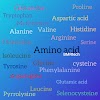Proline | Introduction | History | Biosynthesis.....
PROLINE AMINO ACID
Introduction-
Proline contains a secondary amine group, called an imine, instead of primary amine group. Proline is also called an imino acid. The primary amine on the α carbon of glutamate semialdehyde forms a Schiff base with the aldehyde which is then reduced, yielding proline. Proline is a proteinogenic amino acid that is used in the biosynthesis of proteins. It contains an α-amino group and α-carboxylic acid group and a side chain pyrrolidin, classifying it as a nonpola aliphatic amino acid. It is non-essential in humans, meaning the body can synthesize it from the non-essential amino acid L-glutamate. It is encoded by all the codons starting with CC (CCU, CCC, CCA, and CCG).
When proline is
found in an α helix, the helix will have a slight bend due to the lack of the
hydrogen bond. Proline is often found at the end of α helix or in turns or
loops. The cis and trans forms are nearly
isoenergetic. The cis/trans isomerization can play an
important role in the folding of proteins.
History-
Proline was first discovered in 1900 by Richard Martin Willstätter who obtained the amino acid while studying N-methylproline. The year after Emil Fischer published the synthesis of proline from phthalimide propylmalonic ester. The name proline comes from pyrrolidine one of its constituents.
Structure-
The cyclic structure of proline's side chain gives proline an exceptional conformational rigidity compared to other amino acids. When proline is bound as an amide in a peptide bond, its nitrogen is not bound to any hydrogen, meaning it cannot act as a hydrogen bond donor, but can be a hydrogen bond acceptor. Peptide bond formation with incoming Pro-tRNA is considerably slower than with any other tRNAs, which is a general feature of N-alkylamino acids. The secondary structure of proteins near a proline residue and proline's higher prevalence in the proteins of thermophilic organisms. The cyclic structure of proline's side chain locks the angle φ at approximately −65°.
Properties :-
Chemical formula :- C5H9NO2
Molar mass :- 115.132 g·mol−1
Appearance :- Transparent crystals
Melting point :- 205 to 228 °C (401 to 442 °F; 478 to 501 K) (decomposes)
Thermodynamic data :- Phase behaviour (solid–liquid–gas)
Biosynthesis-
Proline is
biosynthematically derived from the amino acid L-glutamate. Glutamate-5-semialdehyde is first formed
by glutamate 5-kinase (ATP-dependent) and glutamate-5-semialdehyde
dehydrogenase(which requires NADH or NADPH). This can then either
spontaneously cyclize to form 1-pyrroline-5-carboxylic
acid, which is reduced to
proline by pyrroline-5-carboxylate
reductase(using
NADH or NADPH), or turned into ornithine by ornithine aminotransferase, followed by cyclisation by ornithine cyclodeaminase to form proline.
Zwitterionic structure of both
proline enantiomers: (S)-proline (left) and (R)-proline.
Function of proline-
Proline
has its major application in blood pressure maintenance, collagen formation,
arteriosclerosis prevention and tissue repair.
L-Proline is an osmoprotectant and therefore is used
in many pharmaceutical, biotechnological applications.
Proline used in the plant tissue culture(growth medium)
because the increase growth of plant.
L-Proline is a major amino acid found in
cartilage and is important for maintaining youthful skin as
well as repair of muscle.








0 Comments